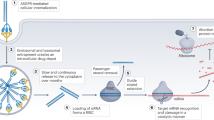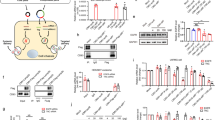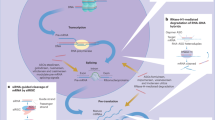Abstract
Systemic administration of synthetic small interfering RNAs (siRNAs) effectively silences hepatocyte gene expression in rodents and primates1,2,3. Whether or not in vivo gene silencing by synthetic siRNA can disrupt the endogenous microRNA (miRNA) pathway remains to be addressed. Here we show that effective target-gene silencing in the mouse and hamster liver can be achieved by systemic administration of synthetic siRNA without any demonstrable effect on miRNA levels or activity. Indeed, siRNA targeting two hepatocyte-specific genes (apolipoprotein B and factor VII) that achieved efficient (∼80%) silencing of messenger RNA transcripts and a third irrelevant siRNA control were administered to mice without significant changes in the levels of three hepatocyte-expressed miRNAs (miR-122, miR-16 and let-7a) or an effect on miRNA activity. Moreover, multiple administrations of an siRNA targeting the hepatocyte-expressed gene Scap in hamsters achieved long-term mRNA silencing without significant changes in miR-122 levels. This study advances the use of siRNAs as safe and effective tools to silence gene transcripts in animal studies, and supports the continued advancement of RNA interference therapeutics using synthetic siRNA.
This is a preview of subscription content, access via your institution
Access options
Subscribe to this journal
Receive 51 print issues and online access
$199.00 per year
only $3.90 per issue
Buy this article
- Purchase on SpringerLink
- Instant access to full article PDF
Prices may be subject to local taxes which are calculated during checkout



Similar content being viewed by others
References
Soutschek, J. et al. Therapeutic silencing of an endogenous gene by systemic administration of modified siRNAs. Nature 432, 173–178 (2004)
Zimmermann, T. S. et al. RNAi-mediated gene silencing in non-human primates. Nature 441, 111–114 (2006)
Song, E. et al. RNA interference targeting Fas protects mice from fulminant hepatitis. Nature Med. 9, 347–351 (2003)
Grimm, D. et al. Fatality in mice due to oversaturation of cellular microRNA/short hairpin RNA pathways. Nature 441, 537–541 (2006)
Narvaiza, I. et al. Effect of adenovirus-mediated RNA interference on endogenous microRNAs in a mouse model of multidrug resistance protein 2 gene silencing. J. Virol. 80, 12236–12247 (2006)
Akinc, A. et al. A combinatorial library of lipid-like materials for delivery of Ray therapeutics. Nature Biotechnol. (submitted)
Esau, C. et al. miR-122 regulation of lipid metabolism revealed by in vivo antisense targeting. Cell Metab. 3, 87–98 (2006)
Krutzfeldt, J., Poy, M. N. & Stoffel, M. Strategies to determine the biological function of microRNAs. Nature Genet. 38 (Suppl). S14–S19 (2006)
Krutzfeldt, J. et al. Silencing of microRNAs in vivo with ‘antagomirs’. Nature 438, 685–689 (2005)
Kim, D. H. et al. Synthetic dsRNA Dicer substrates enhance RNAi potency and efficacy. Nature Biotechnol. 23, 222–226 (2005)
Soutschek, J. et al. Therapeutic silencing of an endogenous gene by systemic administration of modified siRNAs. Nature 432, 173–178 (2004)
Zimmermann, T. S. et al. RNAi-mediated gene silencing in non-human primates. Nature 441, 111–114 (2006)
Krutzfeldt, J. et al. Silencing of microRNAs in vivo with ‘antagomirs’. Nature 438, 685–689 (2005)
Engelking, L. J. et al. Overexpression of Insig-1 in the livers of transgenic mice inhibits SREBP processing and reduces insulin-stimulated lipogenesis. J. Clin. Invest. 113, 1168–1175 (2004)
Shimano, H. et al. Overproduction of cholesterol and fatty acids causes massive liver enlargement in transgenic mice expressing truncated SREBP-1a. J. Clin. Invest. 98, 1575–1584 (1996)
Acknowledgements
We thank A. Wetzel, M. Jayaraman, K. N. Jayaprakash, K. G. Rajeev, L. Nechev and G. Wang for assistance in chemistry; R. Dorkin for liposome preparation; M. Duckman for assistance with the figures; and J. Maraganore for critical advice on the manuscript. M. Spranger is supported by CC-SPMD/ETH. M.G., R.L. and D.G.A. are supported by an NIH grant.
Author Contributions Experimental work was performed by M.J., R.C., A.A., M.G., Y.-A.M. and M. Spranger. Experimental design and critical advice was provided by M.J., R.C., A.A., P.H., J.S., H.-P.V., M.M., M. Stoffel, R.L., D.G.A., J.D.H., V.K. and D.B. The paper was written by D.B.
Author information
Authors and Affiliations
Corresponding author
Ethics declarations
Competing interests
Competing Interests Statement: The following authors are employees of Alnylam Pharmaceuticals, Inc., or Alnylam Europe AG, which develops therapeutics based on siRNAs: M. John, R. Constien, A. Akinc, P. Hadwiger, J. Soutschek, H.-P. Vornlocher, M. Manoharan, V. Koteliansky and D. Bumcrot. In addition, M. Stoffel, R. Langer and D. G. Anderson are consultants to Alnylam. The remaining authors declare no competing interests.
Supplementary information
Supplementary Information
The file contains Supplementary Figures 1-4 with Legends and Supplementary Table 1 with Legend. (PDF 454 kb)
Rights and permissions
About this article
Cite this article
John, M., Constien, R., Akinc, A. et al. Effective RNAi-mediated gene silencing without interruption of the endogenous microRNA pathway. Nature 449, 745–747 (2007). https://doi.org/10.1038/nature06179
Received:
Accepted:
Published:
Issue Date:
DOI: https://doi.org/10.1038/nature06179
This article is cited by
-
Selection of GalNAc-conjugated siRNAs with limited off-target-driven rat hepatotoxicity
Nature Communications (2018)
-
Modulating the water channel AQP4 alters miRNA expression, astrocyte connectivity and water diffusion in the rodent brain
Scientific Reports (2018)
-
Oligonucleotides targeting coagulation factor mRNAs: use in thrombosis and hemophilia research and therapy
Thrombosis Journal (2017)
-
Gene interference strategies as a new tool for the treatment of prostate cancer
Endocrine (2015)
-
Degradable lipid nanoparticles with predictable in vivo siRNA delivery activity
Nature Communications (2014)



